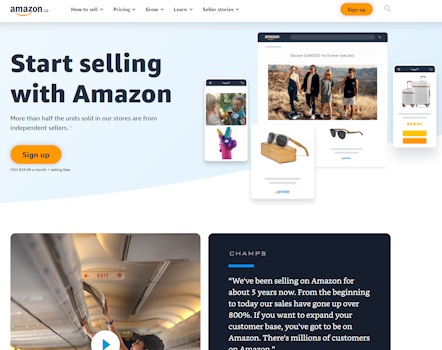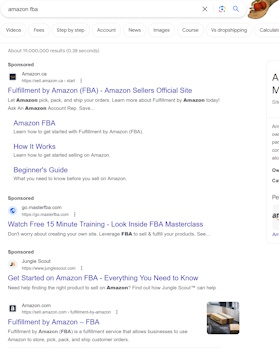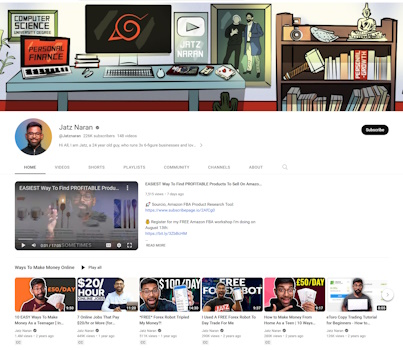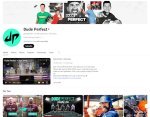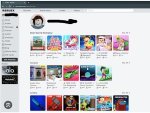Can You Sell On Amazon From Home?

Can you sell on Amazon from home is huge. A lot of people are doing this or just starting out. You can sell anything from hard goods to electronic goods- like ebooks.
If you want to sell "hard" physical products then you can either:
- buy from a wholesaler/ manufacturer
- send the product to your home and then package the product
- sell on a website and use Amazon as the "check out"
- when someone buys you send out the product
- you deal with returns and customer relations
The second is to:
- buy from a wholesaler/ manufacturer
- send the product to Amazon
- sell on a website or use Amazon as the website
- when someone buys Amazon deals with everything
The second- seemingly more attractive version- especially for those who want to sell on Amazon from home.
It is called Amazon FBA- or Fulfillment by Amazon
Fulfillment By Amazon- you possibly can sell on Amazon from home.
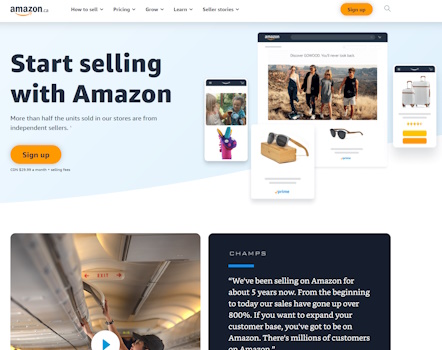
There are many people who suggest that this is a good way to sell on Amazon. We have even been following some here.
So what are the positives?
- Prime Advantage and Customer Trust: Amazon Prime members have come to expect fast and reliable shipping. By utilizing FBA, sellers gain access to Amazon's extensive fulfillment network, which often results in quicker shipping times. Prime eligibility not only attracts more customers but also instills trust due to the association with Amazon's reputable service.
- Global Reach: Amazon's global presence and wide customer base enable businesses to reach international markets with relative ease. Utilizing FBA means that products can be stored in multiple locations around the world, leading to reduced shipping costs and faster deliveries for customers in different countries.
- Scalability and Flexibility: FBA allows businesses to scale rapidly without investing in warehousing and fulfillment infrastructure. As sales increase, Amazon handles the logistical challenges, allowing sellers to focus on marketing, product development, and customer engagement.
- Prime Placement: Products fulfilled by Amazon are often given priority in search results and highlighted with the Prime badge, making them more visible to potential customers. This visibility can significantly boost sales and revenue for sellers.
- Customer Service: Amazon takes care of customer service inquiries, returns, and refunds for FBA products. This relieves sellers of a substantial administrative burden and ensures that customers receive a consistent and efficient service experience.
- Inventory Management: Amazon's advanced inventory management system tracks product levels and adjusts them automatically. This reduces the risk of overselling or running out of stock, enhancing overall operational efficiency.
It all sounds pretty cool. But, with all good things, are there any...like, negatives?
- Costs: While FBA offers convenience, it comes at a price. Sellers need to consider storage fees, fulfillment fees, and other associated charges. For low-margin products, these costs can eat into profits significantly, affecting the overall viability of the business model.
- Loss of Control: Relying on Amazon for fulfillment means relinquishing a degree of control over the shipping and handling process. Any mishaps or errors in packing and shipping are attributed to Amazon, but they can still impact the seller's reputation and customer satisfaction.
- Competition and Saturation: The popularity of FBA has led to a surge in competition among sellers on the platform. As more businesses join FBA, product niches can become saturated, making it harder to stand out and gain a competitive edge. People might take your idea/ product if it is going well (the competitive tools you use, they can too).
- Restricted Access to Customer Information: Amazon handles customer interactions, making it challenging for sellers to build direct relationships with their customers. This limits opportunities for marketing, customer retention, and personalized communication.
- Fulfillment Errors: While Amazon strives for accuracy, fulfillment errors can still occur, leading to incorrect shipments or damaged products. Sellers may have to deal with customer complaints and returns even though the error was on Amazon's end.
- Long-Term Storage Fees: If products remain in Amazon's warehouses for an extended period, long-term storage fees can accumulate. This poses a risk for sellers who have slow-moving inventory, as it erodes profits over time.
- Suspension Risks: Amazon's strict policies mean that sellers need to adhere to guidelines rigorously. Violations can lead to account suspensions, effectively halting sales until the issue is resolved. This vulnerability can disrupt business operations and revenue streams.
What FBA isn't
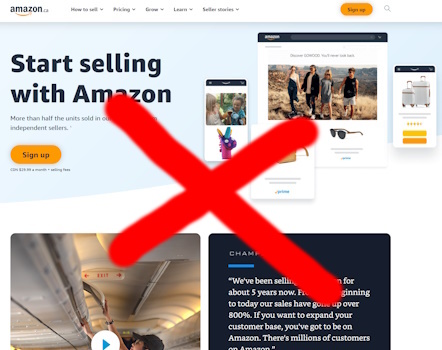
Now, what you might read or watch will tell you that to sell on Amazon from home using FBA is the best thing ever. It is. But...you have to be super careful and figure out what you are trying to achieve.
FBA is a long term growth investment in a vehicle that should not be your primary selling outlet. It should be a selling outlet- but not your main.
Why?
Of all the negative points (cost is quite a big one) the main one for any business or brand that is trying to get bigger is that Amazon keeps all the details of your customer. While it sounds awesome that Amazon handles everything once Amazon has your customer you don't really know anything then about them. How about if you:
- wanted to contact a customer for an upsell
- wanted to tell the customer that you have some cool item coming in the summer
- wanted a follow up
You don't get access to that info.
The only way to access the information is to use your own website/ newsletter/ subscriber list and direct to Amazon a product that is utilising Amazon to sell better/ more of. In this way you are "borrowing" Amazons services/ brand/ tech to make your brand better.
15 Researched ways to promote your FBA product?

Competition is present which ever product you choose- so don't assume that you will not need to promote your product. Heck, even Amazon still promotes- in 2022 Amazon spent $20 billion on advertisements.
However, there are tons of ways to promote your product. The best way is the following:
- find one way that you enjoy, really go for that channel, find the ins and outs. be the best.
Then?
Find another channel and start again.
If you jump from one channel to the other really quickly, you won't have time to figure out what works and how to optimise that channel. You will lose money and sales. Some people write content, jump onto Facebook then do some Twitter then post a quick video. It's nice, but its too many too quick.
Anyway. the most effective ways (through research) to promote an FBA product are the following:
- Optimized Product Listings: A well-optimized product listing is the foundation of successful promotion. Use high-quality images, compelling product descriptions, relevant keywords, and clear bullet points to communicate the value of your product to potential buyers.
- Amazon Pay-Per-Click (PPC) Advertising: Amazon's PPC ads, known as Sponsored Products, allow you to place your product at the top of search results and on product detail pages. These ads are pay-per-click, meaning you only pay when someone clicks on your ad.
- Influencer Collaborations: Partnering with influencers in your product's niche can help you tap into their audience and gain credibility. Influencers can create content showcasing your product and promote it to their followers.
- Social Media Marketing: Utilize platforms like Instagram, Facebook, and TikTok to create engaging content that showcases your product's benefits. Use relevant hashtags, run contests, and encourage user-generated content to increase reach.
- Email Marketing: Build an email list of customers and interested leads. Regularly send out promotional emails, product updates, and exclusive offers to engage and retain your audience.
- Amazon Coupons and Promotions: Amazon offers various promotional tools, such as coupons, lightning deals, and percentage-off promotions. These can attract price-sensitive customers and encourage them to make a purchase.
- Product Giveaways and Contests: Running giveaways or contests can generate buzz around your product. Encourage participants to share your product on social media for a chance to win, increasing visibility.
- Product Inserts: Include inserts in your product packaging that provide customers with a discount code for their next purchase or encourage them to leave a review.
- Amazon Early Reviewer Program: This program encourages customers who have purchased your product to leave a review by offering them a small reward. Positive reviews can boost your product's credibility.
- External Traffic: Drive traffic from external sources, such as your own website, social media, or blog. Include links to your Amazon product page and encourage visitors to check out your product.
- Content Marketing: Create valuable content related to your product's niche. This could include blog posts, videos, or guides that provide useful information to your target audience. Include links to your product within the content.
- Amazon Vine Program: This is an invite-only program where Amazon's top reviewers provide honest reviews of new and pre-release products. Positive Vine reviews can help establish credibility for your product.
- Loyalty and Reward Programs: Implement loyalty programs that reward repeat customers with exclusive discounts, early access to new products, or other perks.
- Cross-Promotions: Partner with other sellers or brands to cross-promote products. For example, if you sell cooking utensils, you could collaborate with a seller of cooking ingredients.
- Enhanced Brand Content (EBC) and A+ Content: If you have a registered brand on Amazon, you can use EBC or A+ Content to create more visually appealing product listings with enhanced descriptions and images.
Which exact one? Unsure, all have their positives (and negatives) but it is up to you to find which one is most suitable for you, your product and your strengths. But if you look at them, some can be combined. If you have a website and traffic coming into it, highly likely you will then have email. Then you might give email marketing a go. A website will need content, so you would do content marketing. So some are naturally inclined to fit with one another and usually fit with ease.
An overview case study on how to sell on Amazon at home using content marketing

You like content and writing, so how about we go through an example of using content marketing for a fitness product?
Background:
Imagine you're an Amazon seller offering a high-quality fitness resistance band set through Amazon FBA. Your target audience includes fitness enthusiasts, individuals looking to stay active at home, and those seeking convenient workout equipment. To promote your product, you decide to implement a content marketing strategy.
Strategy:
You create a content marketing plan that involves producing valuable and informative content related to fitness, workouts, and home exercise routines. The goal is to attract and engage your target audience by providing them with useful information while subtly promoting your resistance band set.
Implementation:
Blog Posts: You start a blog on your brand's website dedicated to fitness and wellness. You publish well-researched articles such as "Top 10 Resistance Band Exercises for Full-Body Workout" and "Effective Home Workouts Using Resistance Bands." These articles offer step-by-step instructions, videos, and images to guide readers through various exercises using your product.
Video Tutorials: You create engaging video tutorials demonstrating different workouts that can be performed using your resistance bands. These videos are shared on your website, social media platforms, and YouTube. You embed links to your Amazon product page in the video descriptions.
Social Media Content: You regularly post fitness tips, motivational quotes, and short workout videos on your social media profiles. You also share your blog posts and videos to provide value to your followers and encourage them to engage with your content.
Email Newsletter: You start building an email list by offering a free downloadable workout guide in exchange for subscribers' email addresses. You send out regular newsletters containing workout tips, success stories from customers who have used your resistance bands, and exclusive offers for your subscribers.
Guest Blogging: You collaborate with fitness influencers and bloggers to write guest posts for their platforms. These posts highlight the benefits of resistance band workouts and include links back to your blog and Amazon product page.
Infographics: You create visually appealing infographics that illustrate different workout routines and the muscle groups targeted by each exercise. These infographics are shared on social media, your website, and in your blog posts.
Antisipated Results:
Increased Traffic: Your content marketing efforts lead to increased organic traffic to your website as fitness enthusiasts and individuals seeking workout information discover your valuable content.
Engagement: Your social media engagement rates improve as followers like, comment, and share your workout videos and tips.
Brand Authority: Your consistent and informative content establishes your brand as an authority in the fitness niche, building trust among your target audience.
Amazon Traffic: The strategically placed links in your content lead interested readers to your Amazon product page, resulting in increased traffic and potentially higher conversion rates.
Customer Acquisition: Many readers who find your workout content useful are likely to explore your resistance band product on Amazon, potentially leading to increased sales.
Email List Growth: Your email list grows steadily as more users subscribe to receive your workout guides and newsletters, providing you with a direct channel to engage with potential customers.
As you can see just by using one technique can be quite effective. Content is also helpful in that it can be shared quite readily and it can also be evergreen- a topic that has year round engagement.
Sell on Amazon from home- more articles and how-to's
This is where this page gets updated. Check out the following links to articles, how-to's, tips and tricks to sell on Amazon:
How do you increase you Amazon Associate commissions?
Remember as well Amazon is a search engine. Here's what it looks for to rank your product.
Amazon FBA, is it worth it and Youtube
Amazon FBA and 14 researched ways businesses have been successful
You have to ask..should you actually sell anything on Amazon?
Some of the best products to use as an Amazon seller?
What are the business models for 3 top Amazon sellers?
Step by step guide on starting an Amazon FBA business
By Jasonera.com- Copyright © All rights reserved. About. Updates. Disclaimer. Privacy. Mission/ Vision. FAQ
